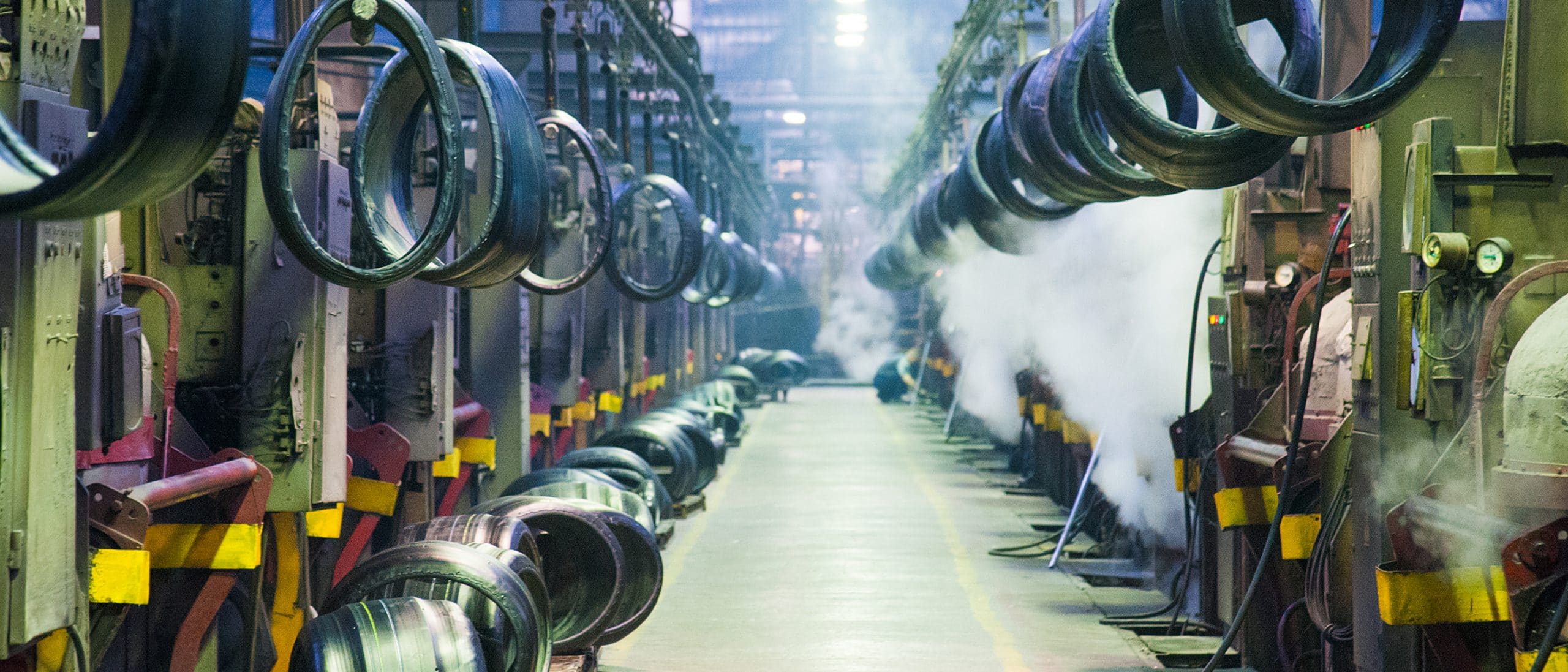Tire and Rubber Industry
Rates of occupational disease are high in tire manufacturing and the rubber industry, caused by exposure to lung and skin toxins.

Exposure in the Tire and Rubber Industry
The manufacture of materials in the tire and rubber industry has increased with the rising number of applications for its products. Medical gloves, tires, certain footwear, and foam-latex products (like mattresses and cushions) are ubiquitous in Americans’ everyday lives.
However, manufacturing rubber goods involves the mixing, heating, formation, and release of a range of chemical carcinogens. These chemicals pose high risks to rubber workers’ health through not only occupational exposure to lung toxins but skin irritants as well.
Common occupational diseases in the tire and rubber industry include emphysema, dermatitis, leukemia, and cancers of the bladder, lung, and larynx. These illnesses can be caused by a variety of compounds that are regularly adjusted or changed from year to year and from company to company. Moreover, the type of occupational exposure a rubber worker experiences depends largely on their role in a plant or factory. Potential areas of production that put workers at risk of exposure include:
- Curing or vulcanizing
- Extruding and calendering
- Inspection and finishing
- Mill operators
- Storage and dispatch

In 1982, the International Agency for Research on Cancer (IARC) released a review of the rubber industry that concluded employees had been exposed to a number of carcinogens and suffered work-related illnesses as a result. The report led to several overhauls in manufacturing.
In 1977, over 88,300 people worked in the rubber industry in the U.S. – before improvements were made that decreased potential occupational diseases. Today, these retired individuals face the development of lung diseases as well as cancer.
Risk Factors for Occupational Disease
While the risk of inhaling toxins is a widely recognized risk factor for occupational disease in the tire and rubber industry, skin exposure presents another source of risk. Whereas inhalation delivers chemicals and dusts to cells via the respiratory system, contact with skin (especially over long periods of time) can lead to the absorption of cancer-causing agents. In fact, some rubber factories have reported soluble dermal exposure levels ten times that of inhalation exposure.
Common exposure risks for lung and skin problems in the rubber industry include:
- 1,3-Butadiene
- Asbestos
- Carbon black
- N-nitrosamines
- Phthalates
- Polycyclic aromatic hydrocarbons (PAHs)
- Silica or silicates
- Solvents (particularly benzene)
- Talc
Their varied molecular structure and variety of effects on the bodies of trade workers make it hard to determine the risk level of individual irritants. Furthermore, only a fraction of the chemicals used are regulated by federal occupational and health agencies.
Typically, risk factors are often grouped according to the responsibilities of the individual during their employment. Workers in rubber curing, processing, and finishing operations are at risk of respiratory complications and chronic pulmonary disease. People who worked near rubber stock and lubricating oils and those who cut or moved rubber products while still hot are at risk for skin disease.
Effects of Exposure
The effects of occupational exposure in the tire and rubber industry include acute (i.e., immediate) illnesses as well as chronic, long-term conditions. Acute symptoms of chemical exposure normally include headache; nausea; fainting; and eye, nose, lung, skin, and throat irritation. Frequently, acute health problems can be cured if they are treated as soon as possible (such as acute bronchitis or occupational asthma).
Continued exposure over years of employment can lead to chronic (and, at times, incurable) health problems. Additionally, lifestyle habits like poor diet and tobacco smoke can worsen many related conditions. Long-term effects of carcinogenic exposure in the rubber industry can include illnesses like:
- Bladder cancer
- Emphysema
- Esophageal cancer
- Larynx cancer
- Leukemia
- Liver cancer
- Lung cancer
- Multiple myeloma
- Pancreatic cancer
- Prostate cancer
- Stomach cancer
Compensation for Tire and Rubber Industry Workers
Often, occupational diseases have long latency periods (such as diseases caused by asbestos exposure), meaning symptoms only appear decades later. Consequently, retired workers in the tire and rubber industry may need legal assistance in seeking compensation for work-related damages.
Previously, workers have reached a settlement through the Labor and Industrial Relations Commission against Goodyear Tire and Rubber for injuries leading to fatal lung cancer.
For information on your diagnosis and case, fill out a free case evaluation form.


